Charles Darwin University: MKT201 Consumer Behavior Case Study
VerifiedAdded on 2023/01/20
|11
|3055
|43
Case Study
AI Summary
This case study examines the consumer behavior and travel decision-making processes of Chinese tourists, focusing on their outbound and inbound travel patterns, particularly concerning Australia. It analyzes the growing significance of the Chinese outbound tourism market and its impact on destinations worldwide, including Australia. The study delves into the changing preferences of Chinese travelers, such as a shift towards prioritizing travel experiences over shopping and a growing interest in local cultures. It identifies key consumer segments like value seekers, shoppers, individualists, and backpackers, highlighting their distinct travel behaviors. The case study also explores the influence of interpersonal factors, including reference groups and social media, on Chinese tourists' travel choices, emphasizing the role of word-of-mouth and online platforms like Sina Weibo and WeChat. Furthermore, it examines situational factors, such as time constraints and antecedent conditions, that affect travel decisions. Finally, it analyzes the specific factors Chinese tourists consider when planning holidays in Australia, providing valuable insights for tourism marketers aiming to attract this important consumer segment. The study emphasizes the importance of understanding these factors to tailor marketing strategies and enhance the appeal of Australia as a travel destination for Chinese tourists.
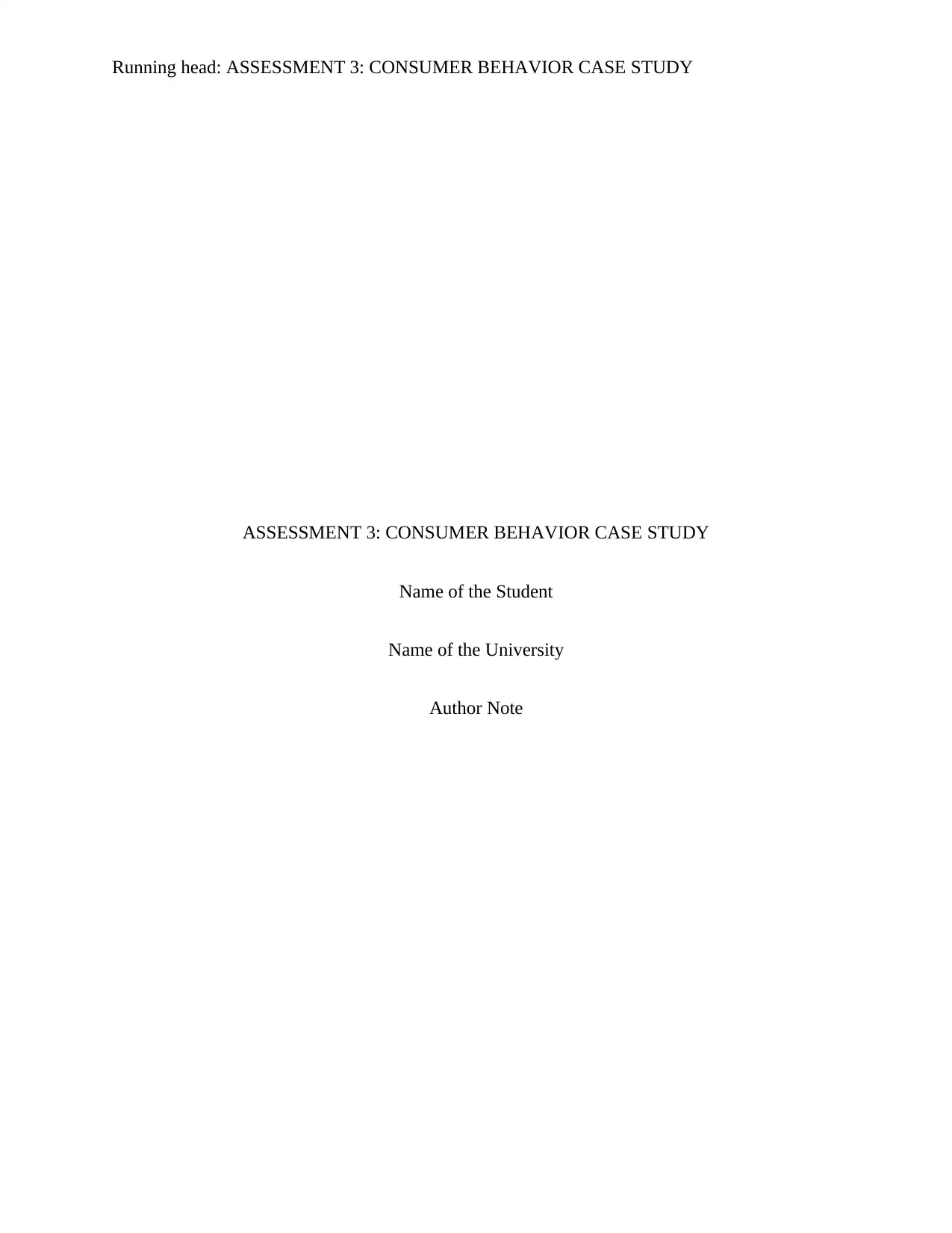
Running head: ASSESSMENT 3: CONSUMER BEHAVIOR CASE STUDY
ASSESSMENT 3: CONSUMER BEHAVIOR CASE STUDY
Name of the Student
Name of the University
Author Note
ASSESSMENT 3: CONSUMER BEHAVIOR CASE STUDY
Name of the Student
Name of the University
Author Note
Paraphrase This Document
Need a fresh take? Get an instant paraphrase of this document with our AI Paraphraser
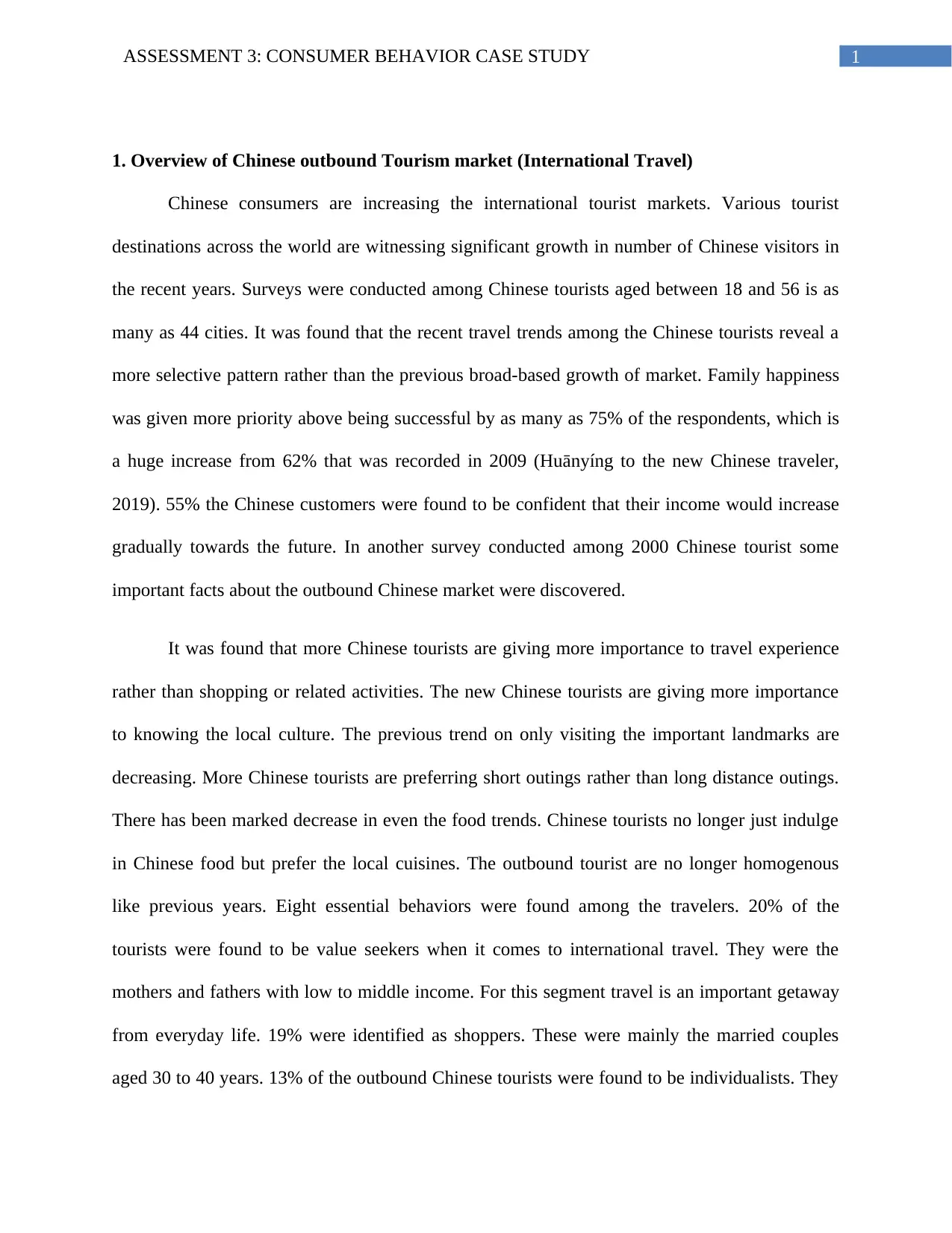
1ASSESSMENT 3: CONSUMER BEHAVIOR CASE STUDY
1. Overview of Chinese outbound Tourism market (International Travel)
Chinese consumers are increasing the international tourist markets. Various tourist
destinations across the world are witnessing significant growth in number of Chinese visitors in
the recent years. Surveys were conducted among Chinese tourists aged between 18 and 56 is as
many as 44 cities. It was found that the recent travel trends among the Chinese tourists reveal a
more selective pattern rather than the previous broad-based growth of market. Family happiness
was given more priority above being successful by as many as 75% of the respondents, which is
a huge increase from 62% that was recorded in 2009 (Huānyíng to the new Chinese traveler,
2019). 55% the Chinese customers were found to be confident that their income would increase
gradually towards the future. In another survey conducted among 2000 Chinese tourist some
important facts about the outbound Chinese market were discovered.
It was found that more Chinese tourists are giving more importance to travel experience
rather than shopping or related activities. The new Chinese tourists are giving more importance
to knowing the local culture. The previous trend on only visiting the important landmarks are
decreasing. More Chinese tourists are preferring short outings rather than long distance outings.
There has been marked decrease in even the food trends. Chinese tourists no longer just indulge
in Chinese food but prefer the local cuisines. The outbound tourist are no longer homogenous
like previous years. Eight essential behaviors were found among the travelers. 20% of the
tourists were found to be value seekers when it comes to international travel. They were the
mothers and fathers with low to middle income. For this segment travel is an important getaway
from everyday life. 19% were identified as shoppers. These were mainly the married couples
aged 30 to 40 years. 13% of the outbound Chinese tourists were found to be individualists. They
1. Overview of Chinese outbound Tourism market (International Travel)
Chinese consumers are increasing the international tourist markets. Various tourist
destinations across the world are witnessing significant growth in number of Chinese visitors in
the recent years. Surveys were conducted among Chinese tourists aged between 18 and 56 is as
many as 44 cities. It was found that the recent travel trends among the Chinese tourists reveal a
more selective pattern rather than the previous broad-based growth of market. Family happiness
was given more priority above being successful by as many as 75% of the respondents, which is
a huge increase from 62% that was recorded in 2009 (Huānyíng to the new Chinese traveler,
2019). 55% the Chinese customers were found to be confident that their income would increase
gradually towards the future. In another survey conducted among 2000 Chinese tourist some
important facts about the outbound Chinese market were discovered.
It was found that more Chinese tourists are giving more importance to travel experience
rather than shopping or related activities. The new Chinese tourists are giving more importance
to knowing the local culture. The previous trend on only visiting the important landmarks are
decreasing. More Chinese tourists are preferring short outings rather than long distance outings.
There has been marked decrease in even the food trends. Chinese tourists no longer just indulge
in Chinese food but prefer the local cuisines. The outbound tourist are no longer homogenous
like previous years. Eight essential behaviors were found among the travelers. 20% of the
tourists were found to be value seekers when it comes to international travel. They were the
mothers and fathers with low to middle income. For this segment travel is an important getaway
from everyday life. 19% were identified as shoppers. These were mainly the married couples
aged 30 to 40 years. 13% of the outbound Chinese tourists were found to be individualists. They
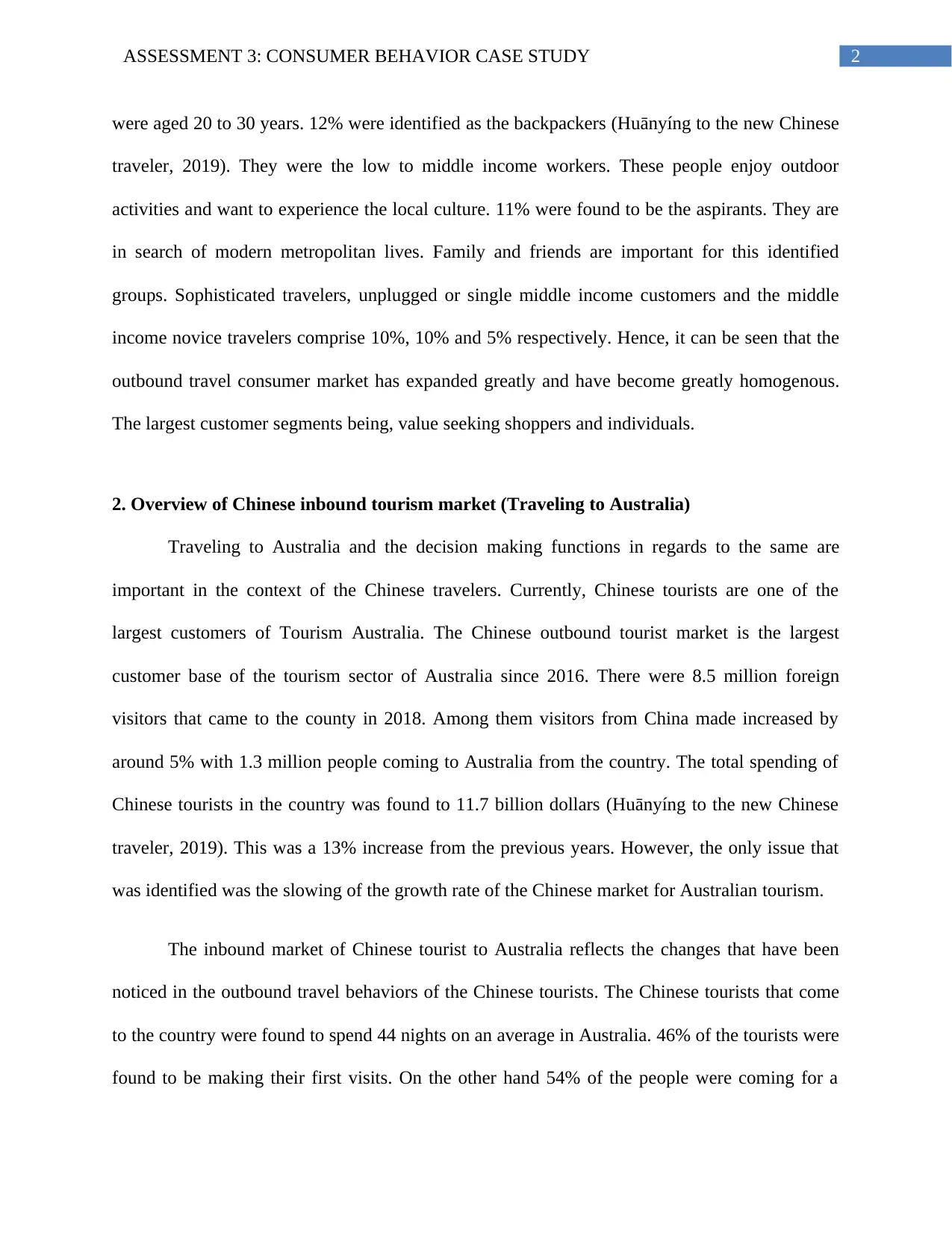
2ASSESSMENT 3: CONSUMER BEHAVIOR CASE STUDY
were aged 20 to 30 years. 12% were identified as the backpackers (Huānyíng to the new Chinese
traveler, 2019). They were the low to middle income workers. These people enjoy outdoor
activities and want to experience the local culture. 11% were found to be the aspirants. They are
in search of modern metropolitan lives. Family and friends are important for this identified
groups. Sophisticated travelers, unplugged or single middle income customers and the middle
income novice travelers comprise 10%, 10% and 5% respectively. Hence, it can be seen that the
outbound travel consumer market has expanded greatly and have become greatly homogenous.
The largest customer segments being, value seeking shoppers and individuals.
2. Overview of Chinese inbound tourism market (Traveling to Australia)
Traveling to Australia and the decision making functions in regards to the same are
important in the context of the Chinese travelers. Currently, Chinese tourists are one of the
largest customers of Tourism Australia. The Chinese outbound tourist market is the largest
customer base of the tourism sector of Australia since 2016. There were 8.5 million foreign
visitors that came to the county in 2018. Among them visitors from China made increased by
around 5% with 1.3 million people coming to Australia from the country. The total spending of
Chinese tourists in the country was found to 11.7 billion dollars (Huānyíng to the new Chinese
traveler, 2019). This was a 13% increase from the previous years. However, the only issue that
was identified was the slowing of the growth rate of the Chinese market for Australian tourism.
The inbound market of Chinese tourist to Australia reflects the changes that have been
noticed in the outbound travel behaviors of the Chinese tourists. The Chinese tourists that come
to the country were found to spend 44 nights on an average in Australia. 46% of the tourists were
found to be making their first visits. On the other hand 54% of the people were coming for a
were aged 20 to 30 years. 12% were identified as the backpackers (Huānyíng to the new Chinese
traveler, 2019). They were the low to middle income workers. These people enjoy outdoor
activities and want to experience the local culture. 11% were found to be the aspirants. They are
in search of modern metropolitan lives. Family and friends are important for this identified
groups. Sophisticated travelers, unplugged or single middle income customers and the middle
income novice travelers comprise 10%, 10% and 5% respectively. Hence, it can be seen that the
outbound travel consumer market has expanded greatly and have become greatly homogenous.
The largest customer segments being, value seeking shoppers and individuals.
2. Overview of Chinese inbound tourism market (Traveling to Australia)
Traveling to Australia and the decision making functions in regards to the same are
important in the context of the Chinese travelers. Currently, Chinese tourists are one of the
largest customers of Tourism Australia. The Chinese outbound tourist market is the largest
customer base of the tourism sector of Australia since 2016. There were 8.5 million foreign
visitors that came to the county in 2018. Among them visitors from China made increased by
around 5% with 1.3 million people coming to Australia from the country. The total spending of
Chinese tourists in the country was found to 11.7 billion dollars (Huānyíng to the new Chinese
traveler, 2019). This was a 13% increase from the previous years. However, the only issue that
was identified was the slowing of the growth rate of the Chinese market for Australian tourism.
The inbound market of Chinese tourist to Australia reflects the changes that have been
noticed in the outbound travel behaviors of the Chinese tourists. The Chinese tourists that come
to the country were found to spend 44 nights on an average in Australia. 46% of the tourists were
found to be making their first visits. On the other hand 54% of the people were coming for a
⊘ This is a preview!⊘
Do you want full access?
Subscribe today to unlock all pages.

Trusted by 1+ million students worldwide
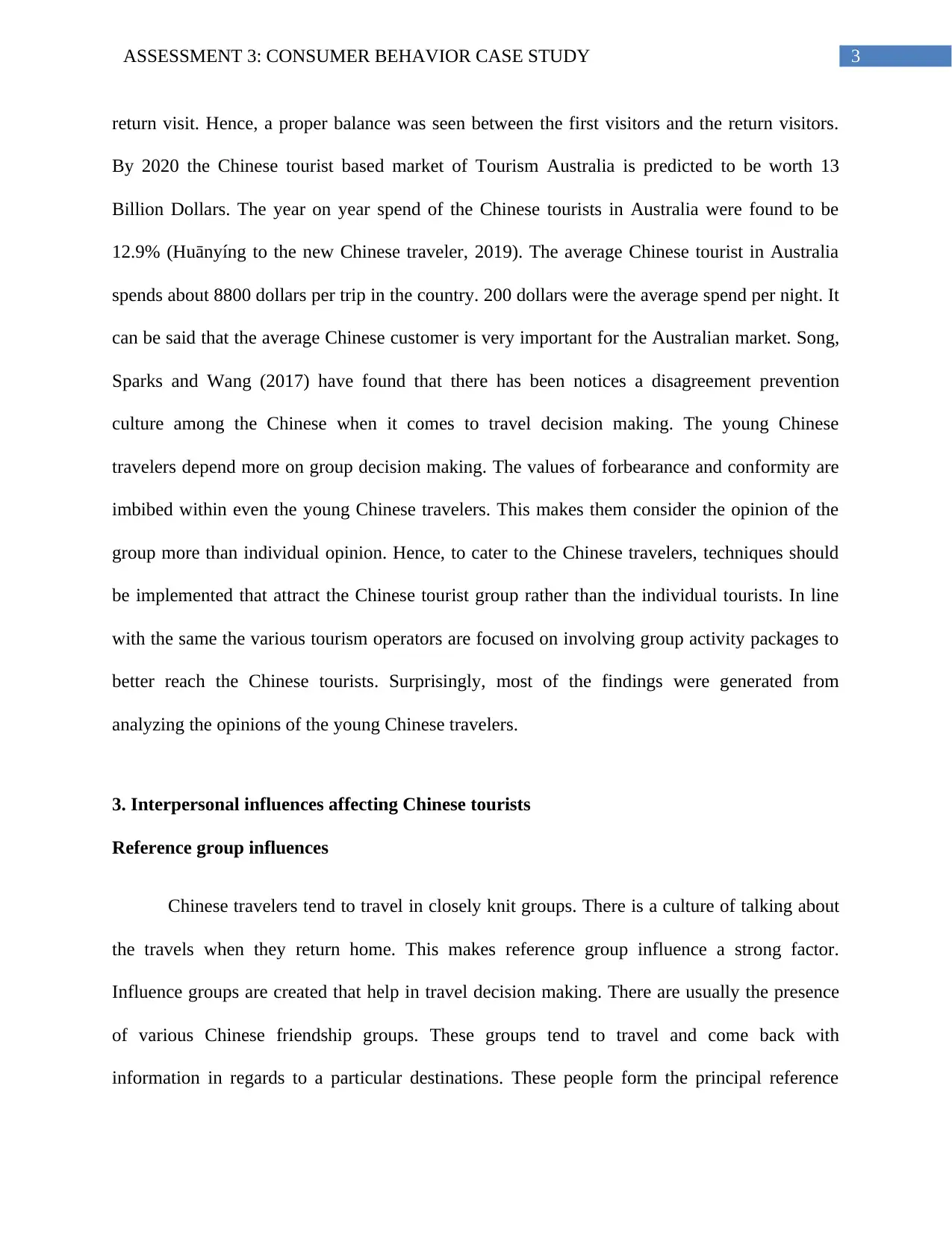
3ASSESSMENT 3: CONSUMER BEHAVIOR CASE STUDY
return visit. Hence, a proper balance was seen between the first visitors and the return visitors.
By 2020 the Chinese tourist based market of Tourism Australia is predicted to be worth 13
Billion Dollars. The year on year spend of the Chinese tourists in Australia were found to be
12.9% (Huānyíng to the new Chinese traveler, 2019). The average Chinese tourist in Australia
spends about 8800 dollars per trip in the country. 200 dollars were the average spend per night. It
can be said that the average Chinese customer is very important for the Australian market. Song,
Sparks and Wang (2017) have found that there has been notices a disagreement prevention
culture among the Chinese when it comes to travel decision making. The young Chinese
travelers depend more on group decision making. The values of forbearance and conformity are
imbibed within even the young Chinese travelers. This makes them consider the opinion of the
group more than individual opinion. Hence, to cater to the Chinese travelers, techniques should
be implemented that attract the Chinese tourist group rather than the individual tourists. In line
with the same the various tourism operators are focused on involving group activity packages to
better reach the Chinese tourists. Surprisingly, most of the findings were generated from
analyzing the opinions of the young Chinese travelers.
3. Interpersonal influences affecting Chinese tourists
Reference group influences
Chinese travelers tend to travel in closely knit groups. There is a culture of talking about
the travels when they return home. This makes reference group influence a strong factor.
Influence groups are created that help in travel decision making. There are usually the presence
of various Chinese friendship groups. These groups tend to travel and come back with
information in regards to a particular destinations. These people form the principal reference
return visit. Hence, a proper balance was seen between the first visitors and the return visitors.
By 2020 the Chinese tourist based market of Tourism Australia is predicted to be worth 13
Billion Dollars. The year on year spend of the Chinese tourists in Australia were found to be
12.9% (Huānyíng to the new Chinese traveler, 2019). The average Chinese tourist in Australia
spends about 8800 dollars per trip in the country. 200 dollars were the average spend per night. It
can be said that the average Chinese customer is very important for the Australian market. Song,
Sparks and Wang (2017) have found that there has been notices a disagreement prevention
culture among the Chinese when it comes to travel decision making. The young Chinese
travelers depend more on group decision making. The values of forbearance and conformity are
imbibed within even the young Chinese travelers. This makes them consider the opinion of the
group more than individual opinion. Hence, to cater to the Chinese travelers, techniques should
be implemented that attract the Chinese tourist group rather than the individual tourists. In line
with the same the various tourism operators are focused on involving group activity packages to
better reach the Chinese tourists. Surprisingly, most of the findings were generated from
analyzing the opinions of the young Chinese travelers.
3. Interpersonal influences affecting Chinese tourists
Reference group influences
Chinese travelers tend to travel in closely knit groups. There is a culture of talking about
the travels when they return home. This makes reference group influence a strong factor.
Influence groups are created that help in travel decision making. There are usually the presence
of various Chinese friendship groups. These groups tend to travel and come back with
information in regards to a particular destinations. These people form the principal reference
Paraphrase This Document
Need a fresh take? Get an instant paraphrase of this document with our AI Paraphraser
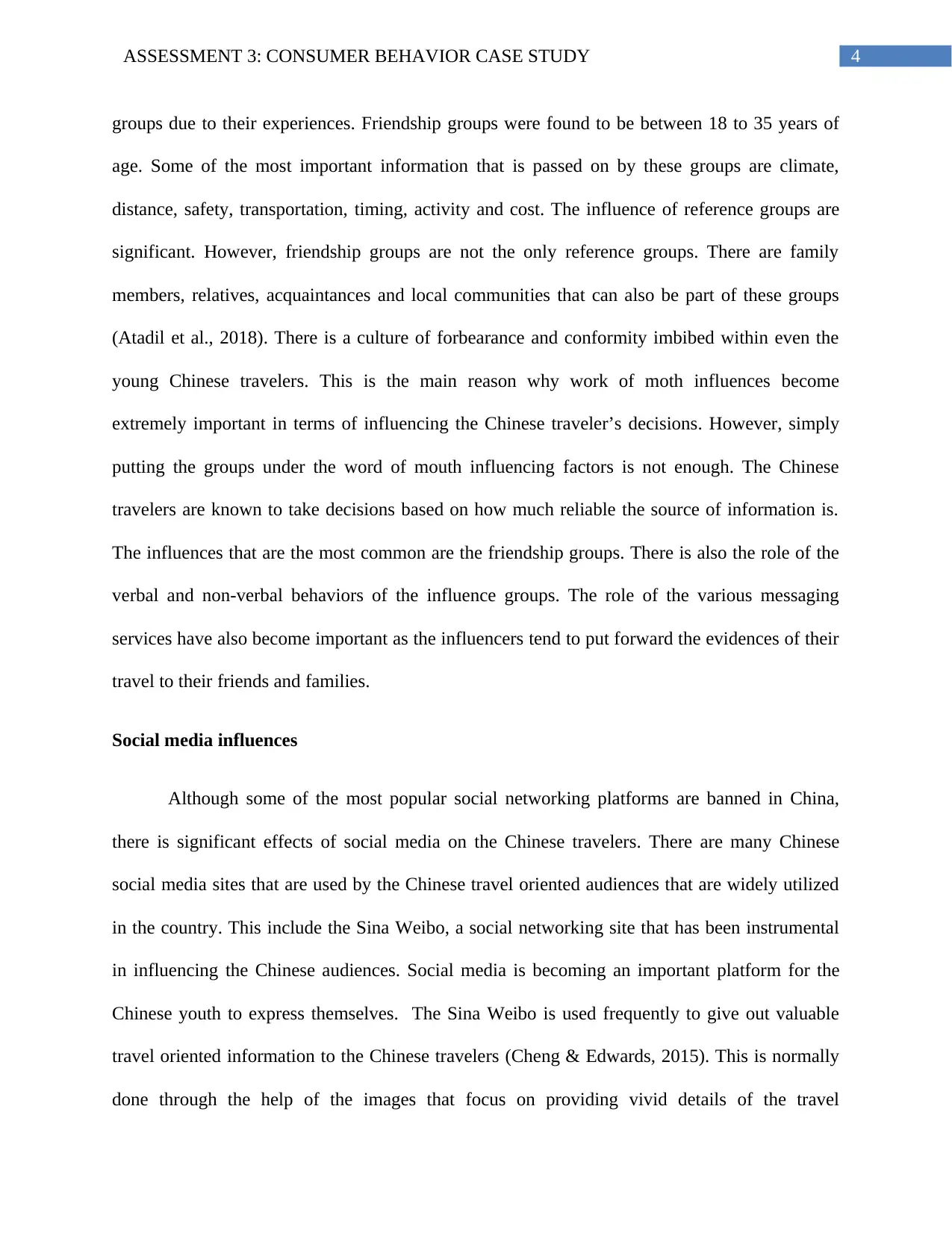
4ASSESSMENT 3: CONSUMER BEHAVIOR CASE STUDY
groups due to their experiences. Friendship groups were found to be between 18 to 35 years of
age. Some of the most important information that is passed on by these groups are climate,
distance, safety, transportation, timing, activity and cost. The influence of reference groups are
significant. However, friendship groups are not the only reference groups. There are family
members, relatives, acquaintances and local communities that can also be part of these groups
(Atadil et al., 2018). There is a culture of forbearance and conformity imbibed within even the
young Chinese travelers. This is the main reason why work of moth influences become
extremely important in terms of influencing the Chinese traveler’s decisions. However, simply
putting the groups under the word of mouth influencing factors is not enough. The Chinese
travelers are known to take decisions based on how much reliable the source of information is.
The influences that are the most common are the friendship groups. There is also the role of the
verbal and non-verbal behaviors of the influence groups. The role of the various messaging
services have also become important as the influencers tend to put forward the evidences of their
travel to their friends and families.
Social media influences
Although some of the most popular social networking platforms are banned in China,
there is significant effects of social media on the Chinese travelers. There are many Chinese
social media sites that are used by the Chinese travel oriented audiences that are widely utilized
in the country. This include the Sina Weibo, a social networking site that has been instrumental
in influencing the Chinese audiences. Social media is becoming an important platform for the
Chinese youth to express themselves. The Sina Weibo is used frequently to give out valuable
travel oriented information to the Chinese travelers (Cheng & Edwards, 2015). This is normally
done through the help of the images that focus on providing vivid details of the travel
groups due to their experiences. Friendship groups were found to be between 18 to 35 years of
age. Some of the most important information that is passed on by these groups are climate,
distance, safety, transportation, timing, activity and cost. The influence of reference groups are
significant. However, friendship groups are not the only reference groups. There are family
members, relatives, acquaintances and local communities that can also be part of these groups
(Atadil et al., 2018). There is a culture of forbearance and conformity imbibed within even the
young Chinese travelers. This is the main reason why work of moth influences become
extremely important in terms of influencing the Chinese traveler’s decisions. However, simply
putting the groups under the word of mouth influencing factors is not enough. The Chinese
travelers are known to take decisions based on how much reliable the source of information is.
The influences that are the most common are the friendship groups. There is also the role of the
verbal and non-verbal behaviors of the influence groups. The role of the various messaging
services have also become important as the influencers tend to put forward the evidences of their
travel to their friends and families.
Social media influences
Although some of the most popular social networking platforms are banned in China,
there is significant effects of social media on the Chinese travelers. There are many Chinese
social media sites that are used by the Chinese travel oriented audiences that are widely utilized
in the country. This include the Sina Weibo, a social networking site that has been instrumental
in influencing the Chinese audiences. Social media is becoming an important platform for the
Chinese youth to express themselves. The Sina Weibo is used frequently to give out valuable
travel oriented information to the Chinese travelers (Cheng & Edwards, 2015). This is normally
done through the help of the images that focus on providing vivid details of the travel
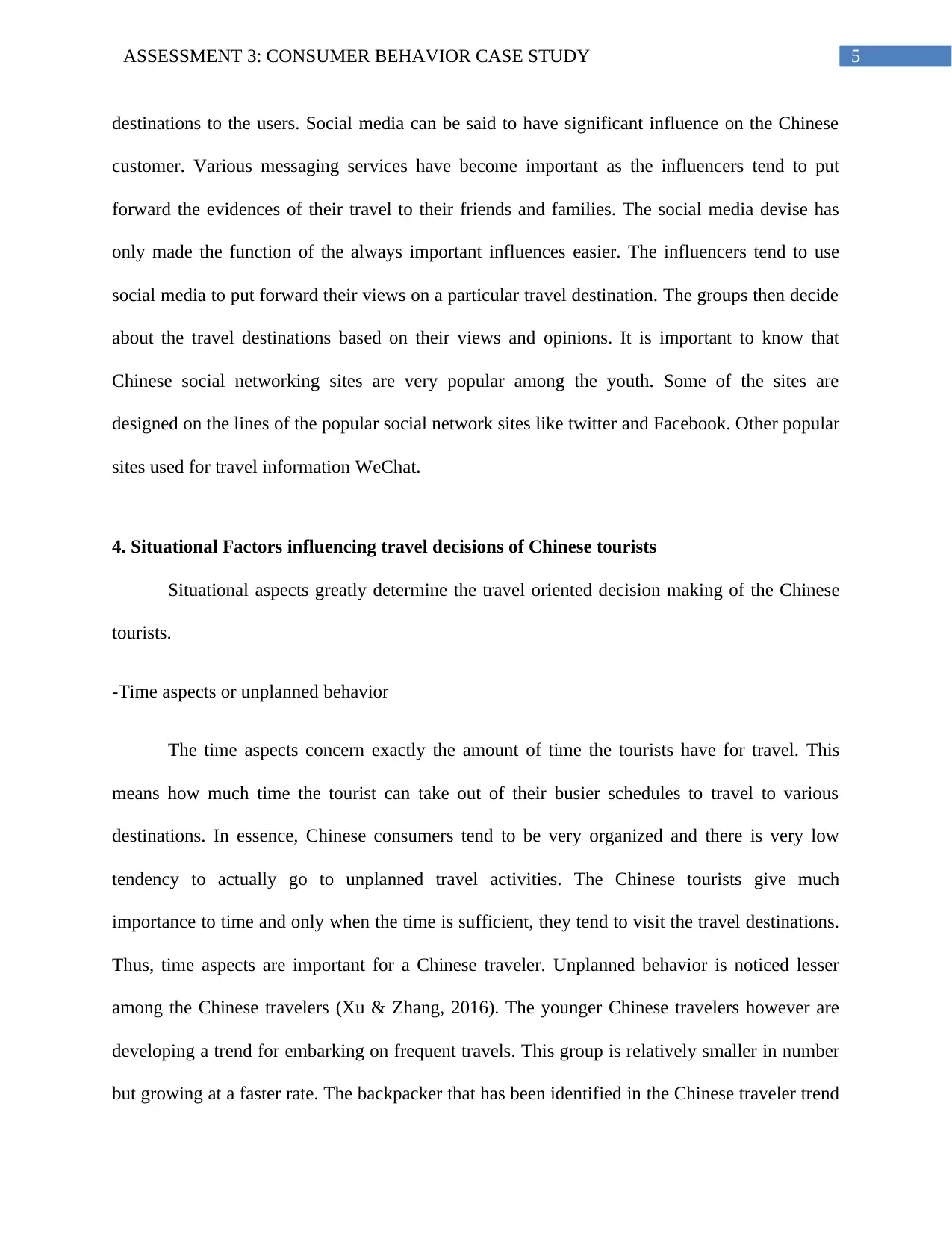
5ASSESSMENT 3: CONSUMER BEHAVIOR CASE STUDY
destinations to the users. Social media can be said to have significant influence on the Chinese
customer. Various messaging services have become important as the influencers tend to put
forward the evidences of their travel to their friends and families. The social media devise has
only made the function of the always important influences easier. The influencers tend to use
social media to put forward their views on a particular travel destination. The groups then decide
about the travel destinations based on their views and opinions. It is important to know that
Chinese social networking sites are very popular among the youth. Some of the sites are
designed on the lines of the popular social network sites like twitter and Facebook. Other popular
sites used for travel information WeChat.
4. Situational Factors influencing travel decisions of Chinese tourists
Situational aspects greatly determine the travel oriented decision making of the Chinese
tourists.
-Time aspects or unplanned behavior
The time aspects concern exactly the amount of time the tourists have for travel. This
means how much time the tourist can take out of their busier schedules to travel to various
destinations. In essence, Chinese consumers tend to be very organized and there is very low
tendency to actually go to unplanned travel activities. The Chinese tourists give much
importance to time and only when the time is sufficient, they tend to visit the travel destinations.
Thus, time aspects are important for a Chinese traveler. Unplanned behavior is noticed lesser
among the Chinese travelers (Xu & Zhang, 2016). The younger Chinese travelers however are
developing a trend for embarking on frequent travels. This group is relatively smaller in number
but growing at a faster rate. The backpacker that has been identified in the Chinese traveler trend
destinations to the users. Social media can be said to have significant influence on the Chinese
customer. Various messaging services have become important as the influencers tend to put
forward the evidences of their travel to their friends and families. The social media devise has
only made the function of the always important influences easier. The influencers tend to use
social media to put forward their views on a particular travel destination. The groups then decide
about the travel destinations based on their views and opinions. It is important to know that
Chinese social networking sites are very popular among the youth. Some of the sites are
designed on the lines of the popular social network sites like twitter and Facebook. Other popular
sites used for travel information WeChat.
4. Situational Factors influencing travel decisions of Chinese tourists
Situational aspects greatly determine the travel oriented decision making of the Chinese
tourists.
-Time aspects or unplanned behavior
The time aspects concern exactly the amount of time the tourists have for travel. This
means how much time the tourist can take out of their busier schedules to travel to various
destinations. In essence, Chinese consumers tend to be very organized and there is very low
tendency to actually go to unplanned travel activities. The Chinese tourists give much
importance to time and only when the time is sufficient, they tend to visit the travel destinations.
Thus, time aspects are important for a Chinese traveler. Unplanned behavior is noticed lesser
among the Chinese travelers (Xu & Zhang, 2016). The younger Chinese travelers however are
developing a trend for embarking on frequent travels. This group is relatively smaller in number
but growing at a faster rate. The backpacker that has been identified in the Chinese traveler trend
⊘ This is a preview!⊘
Do you want full access?
Subscribe today to unlock all pages.

Trusted by 1+ million students worldwide
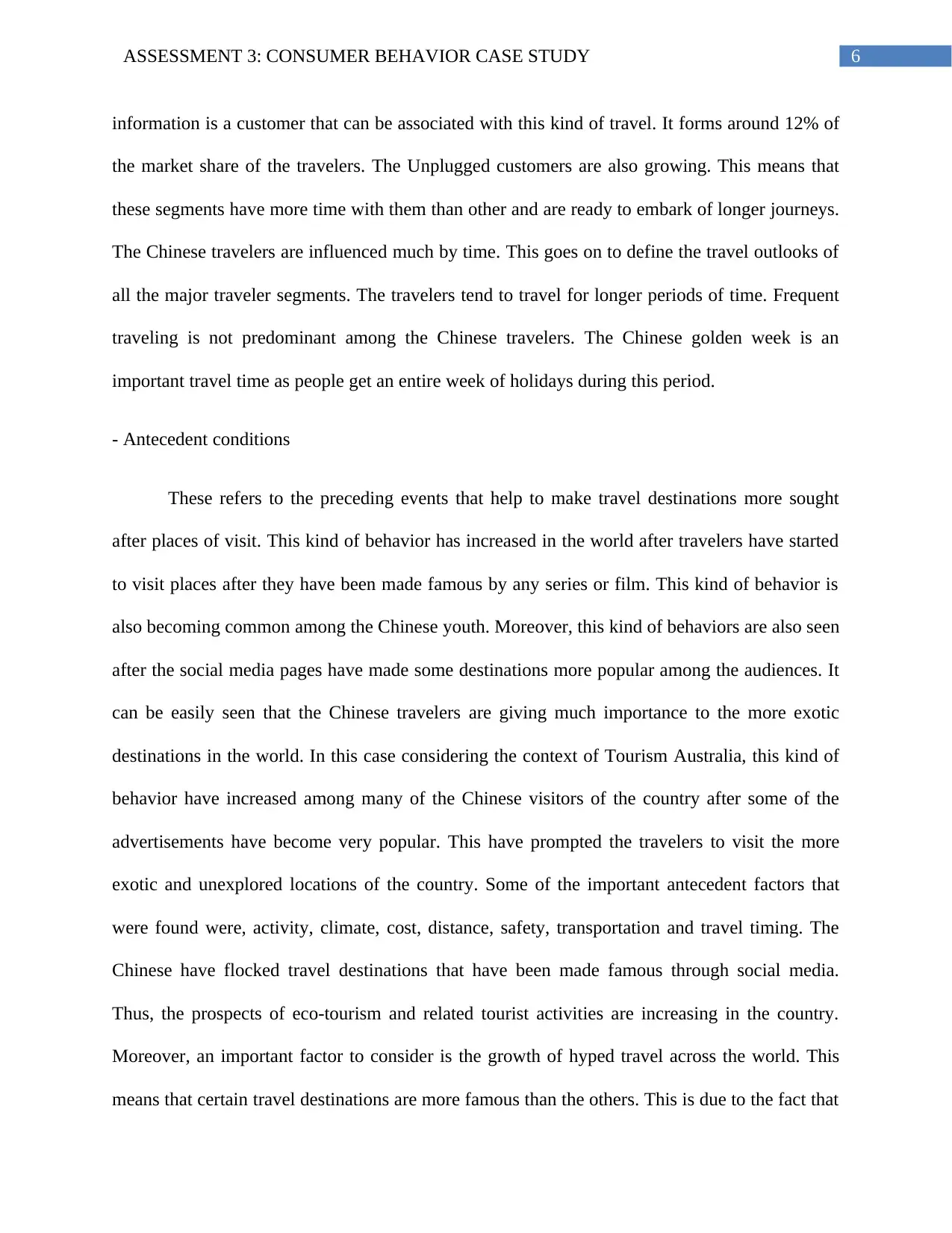
6ASSESSMENT 3: CONSUMER BEHAVIOR CASE STUDY
information is a customer that can be associated with this kind of travel. It forms around 12% of
the market share of the travelers. The Unplugged customers are also growing. This means that
these segments have more time with them than other and are ready to embark of longer journeys.
The Chinese travelers are influenced much by time. This goes on to define the travel outlooks of
all the major traveler segments. The travelers tend to travel for longer periods of time. Frequent
traveling is not predominant among the Chinese travelers. The Chinese golden week is an
important travel time as people get an entire week of holidays during this period.
- Antecedent conditions
These refers to the preceding events that help to make travel destinations more sought
after places of visit. This kind of behavior has increased in the world after travelers have started
to visit places after they have been made famous by any series or film. This kind of behavior is
also becoming common among the Chinese youth. Moreover, this kind of behaviors are also seen
after the social media pages have made some destinations more popular among the audiences. It
can be easily seen that the Chinese travelers are giving much importance to the more exotic
destinations in the world. In this case considering the context of Tourism Australia, this kind of
behavior have increased among many of the Chinese visitors of the country after some of the
advertisements have become very popular. This have prompted the travelers to visit the more
exotic and unexplored locations of the country. Some of the important antecedent factors that
were found were, activity, climate, cost, distance, safety, transportation and travel timing. The
Chinese have flocked travel destinations that have been made famous through social media.
Thus, the prospects of eco-tourism and related tourist activities are increasing in the country.
Moreover, an important factor to consider is the growth of hyped travel across the world. This
means that certain travel destinations are more famous than the others. This is due to the fact that
information is a customer that can be associated with this kind of travel. It forms around 12% of
the market share of the travelers. The Unplugged customers are also growing. This means that
these segments have more time with them than other and are ready to embark of longer journeys.
The Chinese travelers are influenced much by time. This goes on to define the travel outlooks of
all the major traveler segments. The travelers tend to travel for longer periods of time. Frequent
traveling is not predominant among the Chinese travelers. The Chinese golden week is an
important travel time as people get an entire week of holidays during this period.
- Antecedent conditions
These refers to the preceding events that help to make travel destinations more sought
after places of visit. This kind of behavior has increased in the world after travelers have started
to visit places after they have been made famous by any series or film. This kind of behavior is
also becoming common among the Chinese youth. Moreover, this kind of behaviors are also seen
after the social media pages have made some destinations more popular among the audiences. It
can be easily seen that the Chinese travelers are giving much importance to the more exotic
destinations in the world. In this case considering the context of Tourism Australia, this kind of
behavior have increased among many of the Chinese visitors of the country after some of the
advertisements have become very popular. This have prompted the travelers to visit the more
exotic and unexplored locations of the country. Some of the important antecedent factors that
were found were, activity, climate, cost, distance, safety, transportation and travel timing. The
Chinese have flocked travel destinations that have been made famous through social media.
Thus, the prospects of eco-tourism and related tourist activities are increasing in the country.
Moreover, an important factor to consider is the growth of hyped travel across the world. This
means that certain travel destinations are more famous than the others. This is due to the fact that
Paraphrase This Document
Need a fresh take? Get an instant paraphrase of this document with our AI Paraphraser
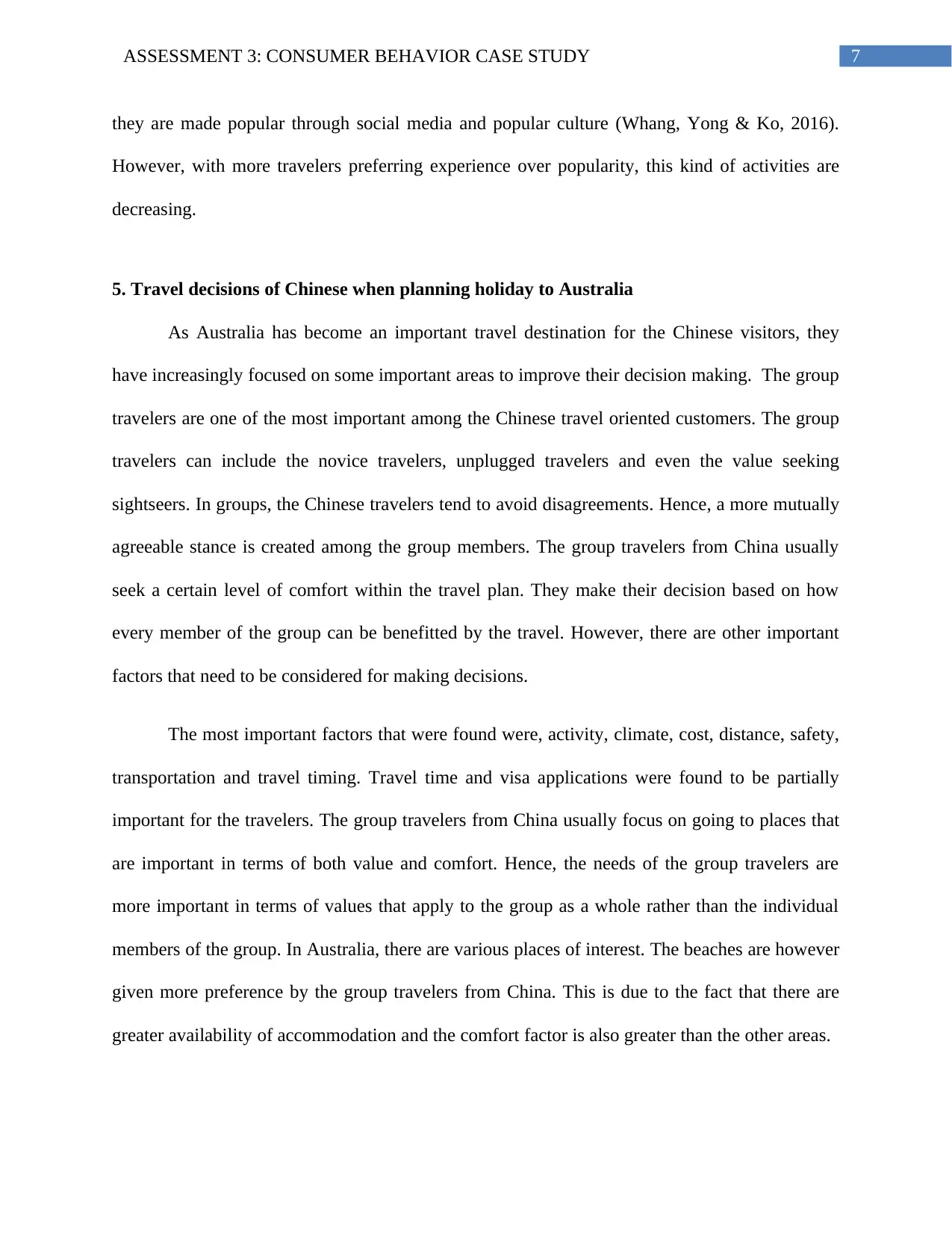
7ASSESSMENT 3: CONSUMER BEHAVIOR CASE STUDY
they are made popular through social media and popular culture (Whang, Yong & Ko, 2016).
However, with more travelers preferring experience over popularity, this kind of activities are
decreasing.
5. Travel decisions of Chinese when planning holiday to Australia
As Australia has become an important travel destination for the Chinese visitors, they
have increasingly focused on some important areas to improve their decision making. The group
travelers are one of the most important among the Chinese travel oriented customers. The group
travelers can include the novice travelers, unplugged travelers and even the value seeking
sightseers. In groups, the Chinese travelers tend to avoid disagreements. Hence, a more mutually
agreeable stance is created among the group members. The group travelers from China usually
seek a certain level of comfort within the travel plan. They make their decision based on how
every member of the group can be benefitted by the travel. However, there are other important
factors that need to be considered for making decisions.
The most important factors that were found were, activity, climate, cost, distance, safety,
transportation and travel timing. Travel time and visa applications were found to be partially
important for the travelers. The group travelers from China usually focus on going to places that
are important in terms of both value and comfort. Hence, the needs of the group travelers are
more important in terms of values that apply to the group as a whole rather than the individual
members of the group. In Australia, there are various places of interest. The beaches are however
given more preference by the group travelers from China. This is due to the fact that there are
greater availability of accommodation and the comfort factor is also greater than the other areas.
they are made popular through social media and popular culture (Whang, Yong & Ko, 2016).
However, with more travelers preferring experience over popularity, this kind of activities are
decreasing.
5. Travel decisions of Chinese when planning holiday to Australia
As Australia has become an important travel destination for the Chinese visitors, they
have increasingly focused on some important areas to improve their decision making. The group
travelers are one of the most important among the Chinese travel oriented customers. The group
travelers can include the novice travelers, unplugged travelers and even the value seeking
sightseers. In groups, the Chinese travelers tend to avoid disagreements. Hence, a more mutually
agreeable stance is created among the group members. The group travelers from China usually
seek a certain level of comfort within the travel plan. They make their decision based on how
every member of the group can be benefitted by the travel. However, there are other important
factors that need to be considered for making decisions.
The most important factors that were found were, activity, climate, cost, distance, safety,
transportation and travel timing. Travel time and visa applications were found to be partially
important for the travelers. The group travelers from China usually focus on going to places that
are important in terms of both value and comfort. Hence, the needs of the group travelers are
more important in terms of values that apply to the group as a whole rather than the individual
members of the group. In Australia, there are various places of interest. The beaches are however
given more preference by the group travelers from China. This is due to the fact that there are
greater availability of accommodation and the comfort factor is also greater than the other areas.
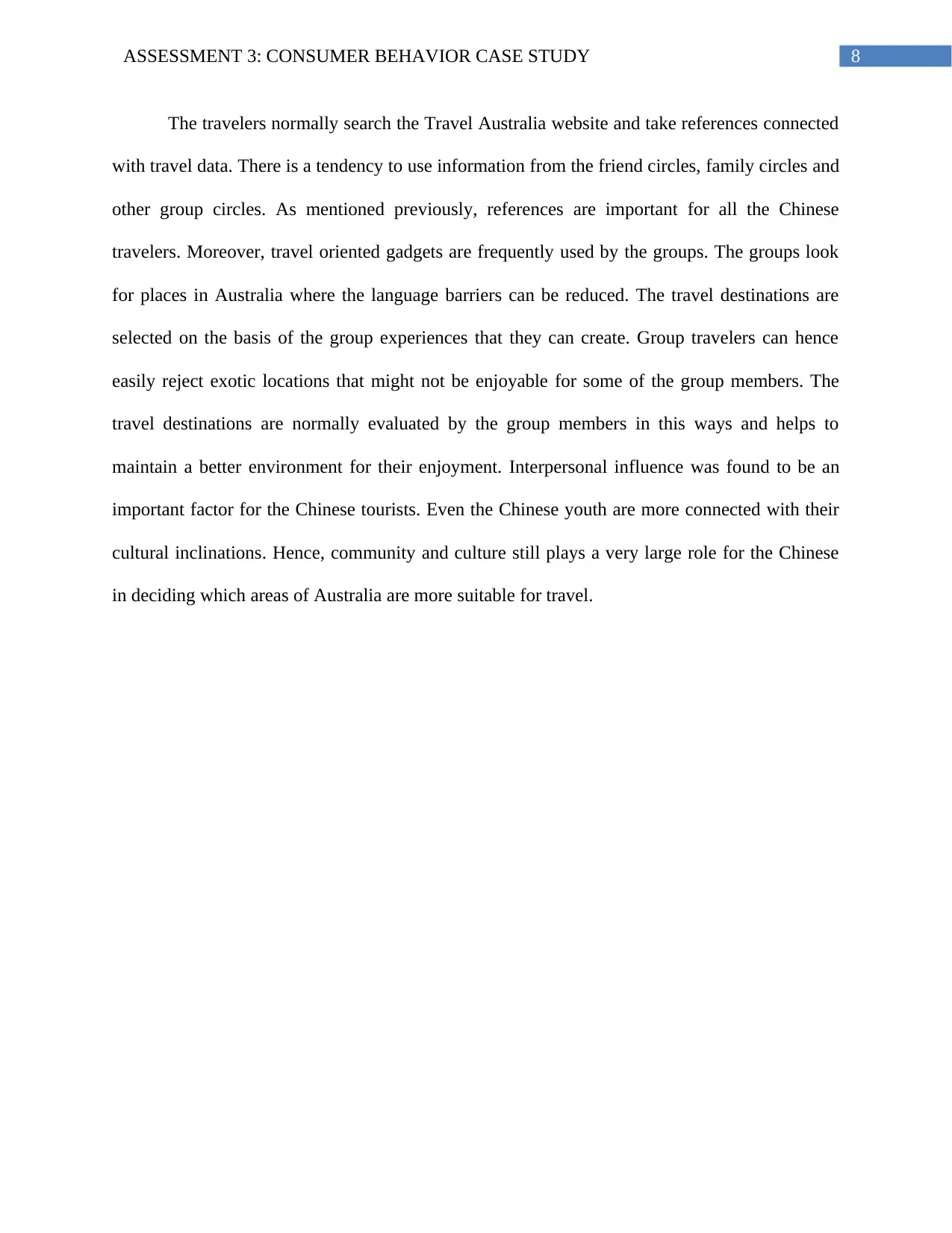
8ASSESSMENT 3: CONSUMER BEHAVIOR CASE STUDY
The travelers normally search the Travel Australia website and take references connected
with travel data. There is a tendency to use information from the friend circles, family circles and
other group circles. As mentioned previously, references are important for all the Chinese
travelers. Moreover, travel oriented gadgets are frequently used by the groups. The groups look
for places in Australia where the language barriers can be reduced. The travel destinations are
selected on the basis of the group experiences that they can create. Group travelers can hence
easily reject exotic locations that might not be enjoyable for some of the group members. The
travel destinations are normally evaluated by the group members in this ways and helps to
maintain a better environment for their enjoyment. Interpersonal influence was found to be an
important factor for the Chinese tourists. Even the Chinese youth are more connected with their
cultural inclinations. Hence, community and culture still plays a very large role for the Chinese
in deciding which areas of Australia are more suitable for travel.
The travelers normally search the Travel Australia website and take references connected
with travel data. There is a tendency to use information from the friend circles, family circles and
other group circles. As mentioned previously, references are important for all the Chinese
travelers. Moreover, travel oriented gadgets are frequently used by the groups. The groups look
for places in Australia where the language barriers can be reduced. The travel destinations are
selected on the basis of the group experiences that they can create. Group travelers can hence
easily reject exotic locations that might not be enjoyable for some of the group members. The
travel destinations are normally evaluated by the group members in this ways and helps to
maintain a better environment for their enjoyment. Interpersonal influence was found to be an
important factor for the Chinese tourists. Even the Chinese youth are more connected with their
cultural inclinations. Hence, community and culture still plays a very large role for the Chinese
in deciding which areas of Australia are more suitable for travel.
⊘ This is a preview!⊘
Do you want full access?
Subscribe today to unlock all pages.

Trusted by 1+ million students worldwide
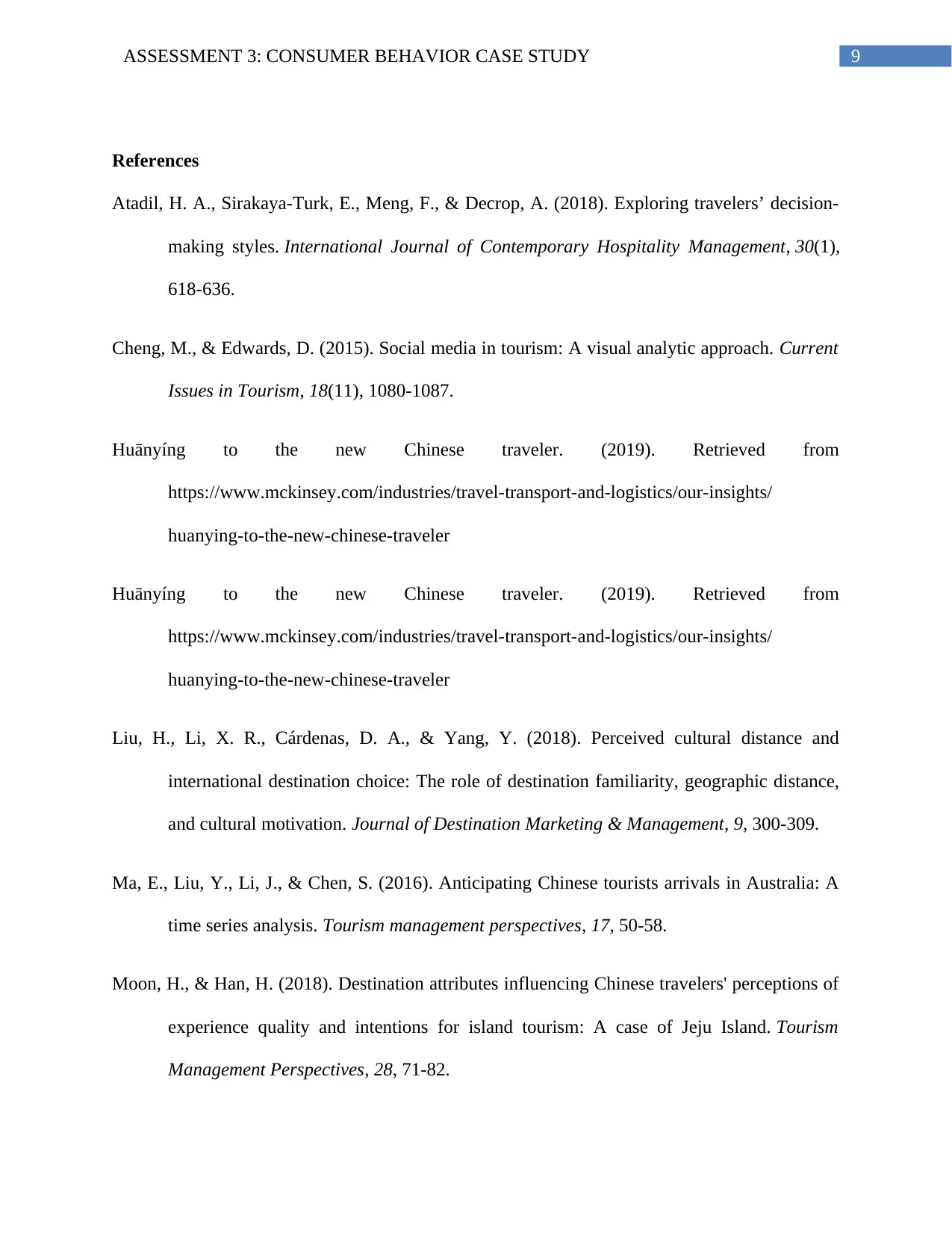
9ASSESSMENT 3: CONSUMER BEHAVIOR CASE STUDY
References
Atadil, H. A., Sirakaya-Turk, E., Meng, F., & Decrop, A. (2018). Exploring travelers’ decision-
making styles. International Journal of Contemporary Hospitality Management, 30(1),
618-636.
Cheng, M., & Edwards, D. (2015). Social media in tourism: A visual analytic approach. Current
Issues in Tourism, 18(11), 1080-1087.
Huānyíng to the new Chinese traveler. (2019). Retrieved from
https://www.mckinsey.com/industries/travel-transport-and-logistics/our-insights/
huanying-to-the-new-chinese-traveler
Huānyíng to the new Chinese traveler. (2019). Retrieved from
https://www.mckinsey.com/industries/travel-transport-and-logistics/our-insights/
huanying-to-the-new-chinese-traveler
Liu, H., Li, X. R., Cárdenas, D. A., & Yang, Y. (2018). Perceived cultural distance and
international destination choice: The role of destination familiarity, geographic distance,
and cultural motivation. Journal of Destination Marketing & Management, 9, 300-309.
Ma, E., Liu, Y., Li, J., & Chen, S. (2016). Anticipating Chinese tourists arrivals in Australia: A
time series analysis. Tourism management perspectives, 17, 50-58.
Moon, H., & Han, H. (2018). Destination attributes influencing Chinese travelers' perceptions of
experience quality and intentions for island tourism: A case of Jeju Island. Tourism
Management Perspectives, 28, 71-82.
References
Atadil, H. A., Sirakaya-Turk, E., Meng, F., & Decrop, A. (2018). Exploring travelers’ decision-
making styles. International Journal of Contemporary Hospitality Management, 30(1),
618-636.
Cheng, M., & Edwards, D. (2015). Social media in tourism: A visual analytic approach. Current
Issues in Tourism, 18(11), 1080-1087.
Huānyíng to the new Chinese traveler. (2019). Retrieved from
https://www.mckinsey.com/industries/travel-transport-and-logistics/our-insights/
huanying-to-the-new-chinese-traveler
Huānyíng to the new Chinese traveler. (2019). Retrieved from
https://www.mckinsey.com/industries/travel-transport-and-logistics/our-insights/
huanying-to-the-new-chinese-traveler
Liu, H., Li, X. R., Cárdenas, D. A., & Yang, Y. (2018). Perceived cultural distance and
international destination choice: The role of destination familiarity, geographic distance,
and cultural motivation. Journal of Destination Marketing & Management, 9, 300-309.
Ma, E., Liu, Y., Li, J., & Chen, S. (2016). Anticipating Chinese tourists arrivals in Australia: A
time series analysis. Tourism management perspectives, 17, 50-58.
Moon, H., & Han, H. (2018). Destination attributes influencing Chinese travelers' perceptions of
experience quality and intentions for island tourism: A case of Jeju Island. Tourism
Management Perspectives, 28, 71-82.
Paraphrase This Document
Need a fresh take? Get an instant paraphrase of this document with our AI Paraphraser
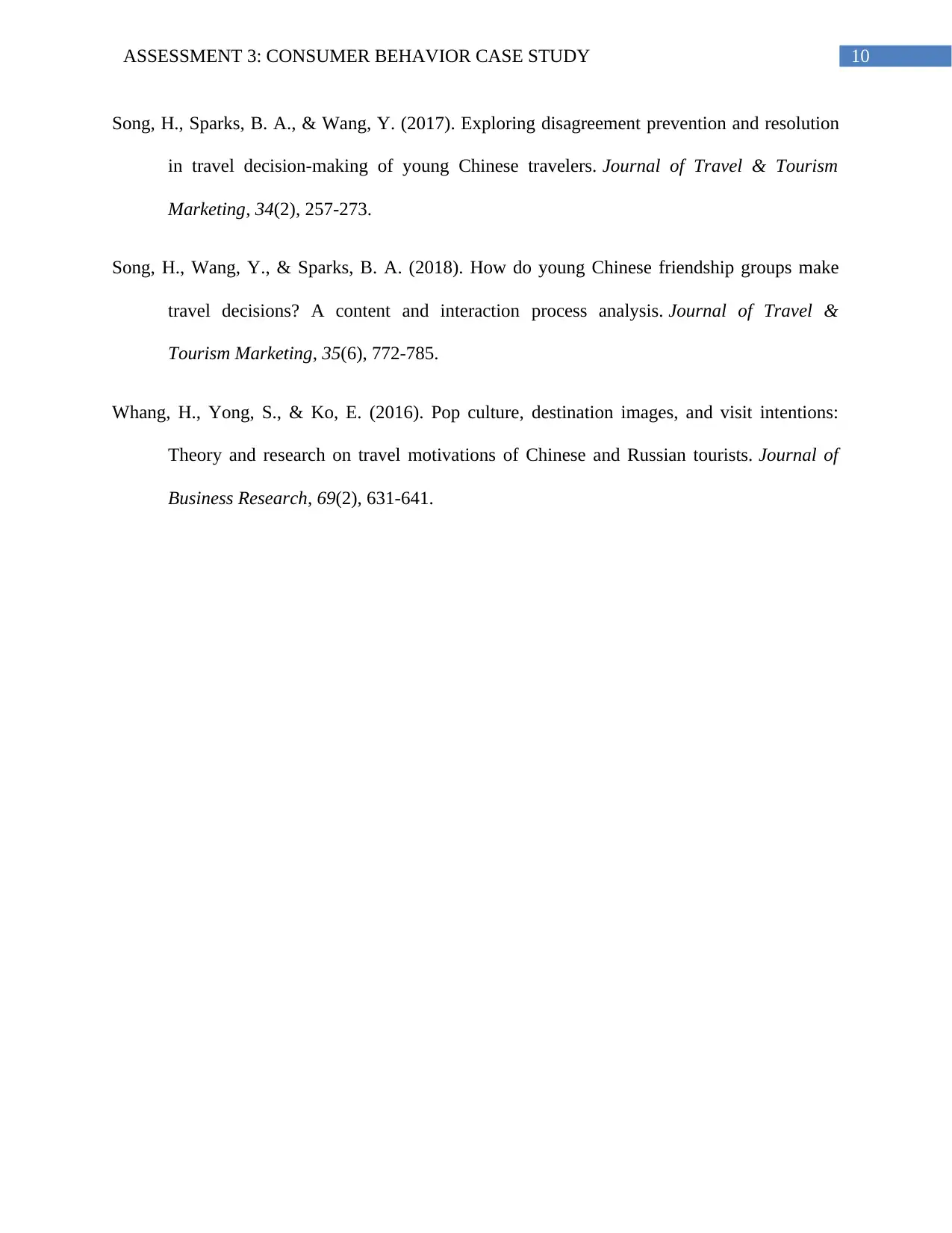
10ASSESSMENT 3: CONSUMER BEHAVIOR CASE STUDY
Song, H., Sparks, B. A., & Wang, Y. (2017). Exploring disagreement prevention and resolution
in travel decision-making of young Chinese travelers. Journal of Travel & Tourism
Marketing, 34(2), 257-273.
Song, H., Wang, Y., & Sparks, B. A. (2018). How do young Chinese friendship groups make
travel decisions? A content and interaction process analysis. Journal of Travel &
Tourism Marketing, 35(6), 772-785.
Whang, H., Yong, S., & Ko, E. (2016). Pop culture, destination images, and visit intentions:
Theory and research on travel motivations of Chinese and Russian tourists. Journal of
Business Research, 69(2), 631-641.
Song, H., Sparks, B. A., & Wang, Y. (2017). Exploring disagreement prevention and resolution
in travel decision-making of young Chinese travelers. Journal of Travel & Tourism
Marketing, 34(2), 257-273.
Song, H., Wang, Y., & Sparks, B. A. (2018). How do young Chinese friendship groups make
travel decisions? A content and interaction process analysis. Journal of Travel &
Tourism Marketing, 35(6), 772-785.
Whang, H., Yong, S., & Ko, E. (2016). Pop culture, destination images, and visit intentions:
Theory and research on travel motivations of Chinese and Russian tourists. Journal of
Business Research, 69(2), 631-641.
1 out of 11
Related Documents
Your All-in-One AI-Powered Toolkit for Academic Success.
+13062052269
info@desklib.com
Available 24*7 on WhatsApp / Email
![[object Object]](/_next/static/media/star-bottom.7253800d.svg)
Unlock your academic potential
Copyright © 2020–2025 A2Z Services. All Rights Reserved. Developed and managed by ZUCOL.





